The main steps or stages in a project
A project can be defined as a designated ally of tasks that aims at accomplishing a certain task within an organization; it has a period, expected expenditure, expected outcome, and a work framework or schedule. The following are the steps/stages in a project:
- Initiation;
- Planning and development;
- Project implementation and execution;
- Monitoring;
- Closure (see the appendixes for the process).
The objectives of Project Management
The following are the main objectives of a project management:
- to plan, organize and control activities
- manage activities and organize resources (both human and physical) for the project
- putting all the logistics of a project into place so that there will be full attainment of project goals and objectives
- Ensuring that the project is accomplished in time with the available resources and if possible have some new strategies of completion of tasks that is better than the original plan.
Project Management triangle
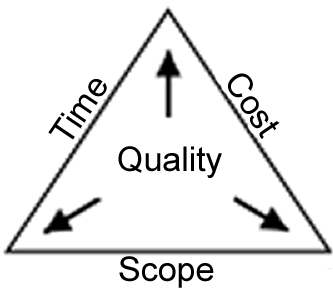
When the time of the project is increased, there are chances that the cost of the project will increase; this is so because more human capital will be required to accomplish the task; alternatively to click a balance the project may have an increased time but the number of employees slashed, this is likely to reduce maintain the cost.
What is the role of a Project Manager?
Project leaders are mandated with the task of ensuring that a project is run effectively and is completed within the set period. When making objectives of a project, managers should ensure that they not only have the goals and objectives set but should be pioneers of policies to see their attainment. In case a management fails to fulfill its leadership role, then the project is likely to fail. Interlink and collaboration of a number of micro-projects calls for integration of management and their skills so as micro-project leaders can enjoy from intellectualism from the other.
The levels of decision-making styles in a company
Decisions are made in the following levels:
- Top management or board decisions: they come up with the overview decisions; they can be seen as the head of a project
- Operational level: they are supervisors and managers of a project
- Team level: they are the team leaders who come up with some project implementation decisions.
Project Management and Operational Management
Project management is specific to certain undertaking that an organization aims at doing; it involves coordinating the activities and processes in a project for successful completion of a project on time having utilized resources effectively.
Operational management on the other hand has a wider approach to the process, it involves ensuring that processes within an organization are coordinated effectively; it involves even ensuing that certain projects are running but gives the final control of the project to project managers.
The characteristics of successful projects & teams
The definition of project team is wide and covers different aspects; however, a team can be defined as a group of people with a common objective to meet within a certain period work. They range from small teams of two people to an entire organization can be referred to as a team. The following are the characteristics of an effectively managed team:
- decisions are made in a democratic manner but the team leader has the final hammer on the decision.
- all members understands their roles, functions and they are well equipped to perform them.
- Team members work for the general good of the organization and the team; organizations are run through different teams that are made to meet certain corporate objectives.
- Team leader effectively manages operations mandated with the task of coordinating and ensuring that things are flowing within a team; he is involved in daily activities of the team but is the reference point in the team.
- Good communication and common vision; the vision is to see the project completed in the right time using the right amount of resources.
- Have highly motivated staffs.
The characteristics of unsuccessful projects & teams
In an ineffectively managed project or project team, the following are the main characteristics that it posses:
- De-motivated staffs; each staffs feels that he has no belonging to the attainment of the project objectives.
- Projects lag behind schedule.
- There is poor communication among the team members and the leader is the sole decision maker.
- Tasks are not effectively allocated and no one can be held fully responsible for a certain task.
- Self interests are vested first than project good.
Activity Dependency Duration
- None 5.
- None 3.
- B 6.
- A 8.
- B 7.
- C 2.
- D, E 4.
- F, G 6.
Dependency Gantt chart and the length of the project

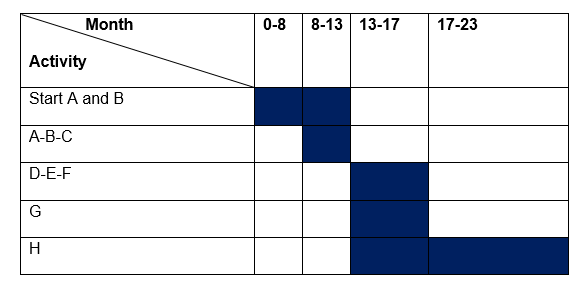
The time of the project is 23 days.
The main advantages and disadvantages of Gantt charts
Advantages
- They offer project managers the chance to see the schedule of the project on a single page.
- They can be used to evaluate the progress of a project as they give the timeframes and the activity respected to be done during that period.
- When well managed, it’s an effective project management tool.
Disadvantages
- The tasks on a Gantt chart are independent thus there is high dependency.
- The charts assume that there will be no flexibility in the project, however at normal process, there are changes that arise in course of project process.
The differences between AoA and AoN network diagrams
AoA illustrates the start of an activity from the start to the end of the activity, it shows the finish-to-start relationships of activities in a pert diagram; the arrows shows activities that have complicated relationships and dependencies.
AoN on the other hand shows the interrelationship that exists between activities; it shows those activities on a node that relationship is simple and can be well illustrated and any delay time removed.
The main differences between a standard critical path diagram and a PERT diagram
The main difference is on the way each allocates time; in the case of Standard Critical path, the approach uses the expected time, which in most cases is the average of time to be used, while when it comes to PERT approach it times the best case; this is the expected situation and uses the worst-case approach. The formulae for the time used in PERT IS:
Average Time = (Best Case + (4 x Expected Case) + Worst Case) / 6.
Using the information given in the table above, using simple resource analysis determine how many people are required and when for this project. Assume that one person is required to carry out each activity.
Since the project has eight processes, and every process needs one person, the total number of people required will be eight of them.
The advantages and disadvantages of using Project Management software
Advantages
- It monitors the progress of the project and ensure that incase there is a deviation from the expected, then it can offer some warnings
- They are simpler management tools that can be manipulated and results interpolated to calculate the best strategy and pathway for the program.
Disadvantages
- It is expensive to come with a system for every project
- They may offer some misleading information since they assume rigidity of processes.
Difference between a group and a team
A team is well organized with proper leadership and cohesion of members; it has some specified goals and objectives that it has to attain within a certain period using some specified levels of resources. In a team, every member has the sole aim of performing his own task, roles and undertaking responsibilities with the aim of meeting the team’s objectives, goals, vision and mission.
A group on the other hand is a collection of people with something that creates identity among each other, for example, they may be people from the same locality, people who support a certain team, or even a group of mob doing something in common. In groups, there is no well-framed leadership and neither of the group members can be held accountable of the other or of a certain task undertaken.
Leaders within an organization should ensure they develop teams from groups, it is through the development of orchestrate teams that the team will attain its corporate goals and objectives.
Distinguishing between functional and team roles
Teams have roles to play to ensure that their objectives as well as their firms objectives have been met effectively; form a broad angle, teams roles can be classified as functional and team roles:
Functional roles are the responsibilities that a certain team member is mandated to undertake in order to make the entire team to function effectively. For example in a construction project; the team may have someone responsible for supplying water to the project; the persons role will be restricted to that function and his effectiveness and efficiency in the areas will translate to overall good of the entire program.
Team roles are the roles that someone is allocated within the team, they are the responsibilities that a certain person is supposed to handle as far as the operation of the team is concerned. For example if team leaders have the role of ensuring that all processes are working according to the planned was and in line with the initiation documents.
Belbin’s team roles
According to Belbins team roles, the roles of a team can be divided into nine main areas as:
- Plant. This involves placing the right person to the right task; when doing this, the team manager looks into talent, skills, and experience of the individual team members.
- Monitor/Evaluator. The team should have some cohesion and have better approached to the situations in hand to ensure that any problem that arises has been solved in the best way possible. it is good to appreciate that in team, there are likely to have some conflicts, some challenges and some issues that might have been overlooked when enacting the program, managers should not let them ruin the success of their project.
- Implementer. The idea behind a team is to come-up with the right combination of efforts tasks, powers, and strengths, when they are well blend, then the team can have some power and the strength to accomplish tasks together. When team efforts and powers have been combined, then there is the development of an orchestrate team and its success is almost guaranteed.
- Team worker. The attainment of a team’s goals and objectives depends on how well the human resources have been managed; managing project teams involves enacting policies and strategies that create an environment that team members can use their intellectualism to the good of the company.
- Specialist. Teams have their efforts, skills and eyes focused on a certain area or something that they want to attain; this focus means they should have the skills, the focus and the direction they are following for their own good. Well-managed team should ensure they have the focus and clear direction.
- Completer Finishers. As much as teams are there to attain certain objective, they are people, they need to socialize and have some social practices and matters; this will assist them in building cohesions good for an effective operation of a team. To have good socialization, team managers should develop effective communication channels.
- Thinking. When team is operating effectively, they are using their thoughts, expertise and experiences to accomplish a certain task; the operating environment should be favorable for the growth of good thoughts and building of intellectual capacity.
- Co-coordinators. Making decisions, planning, socializing all blend to the actual doing of the project; teams efforts should be made to facilitate good business in the company.
- Resource Investigators. Team are expected to manage the available resources and ensure that incase there is a better way of using the resources, the team should have the structures and mechanisms to realize and use them.
Team lifecycle
Teams are made from available human resources and sourcing for external human resources. When developing a team, the initial point is defining the task, then interpolating the resources that a company has. The available internal resources should be scrutinized and enforced by other experts if they do not have the capacity. The task that need to be accomplished should be analyzed, objective and goals set; with the task understanding and understanding the potential at hand, then managers blend the resources effectively to the benefit of the task. Different personalities, expertise, age and experiences should be combined and team leader elected.
Team cycle has the following processes:
- Forming: at this stage the management tries to merge the available resources, human capital and the available resources; it involves putting the skills, experiences, personal styles, habits and expertise together to have a winning team. This stage is crucial as the result determines the success of the outcome team all parameters should be considered.
- Storming: at this stage, the teams interpersonal differences come into play as people have differences and look for solutions to them; this stage assists is knowing the personalities of the team members for a better combination.
- Norming: at this stage, the team has resolved their differences and they have a common destiny; they respect each other and the spirit of teamwork is building.
- Performance/Dorming: this is making the team act in unison for the good of the project that they are initiating; team members should act not to compete with each other but to have common solutions to issues and be able to handle situations as they come.
- Adjourning: this occurs when there have been a change that suddenly calls for a shift of focus and a change of the team members’ tasks allocation and the way they perceive the operating conditions.
The following diagram illustrates the above roles of a team:
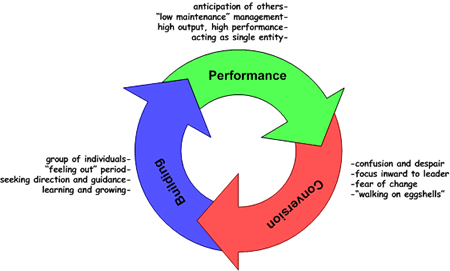
When a team follows the above roles, the successes of there are likely to be attained.
Project Management and Systems Theory
A clear definition of a system
A system in a project means general management approach that integrates different tasks within a project and uses scientific information analysis to come up with the right approach to certain issue facing an organization. It’s a management approach that attempts to looks at issues at hand from a holistic level rather than through the an analysis of individual components; when solving problems, they are looked into utilizing the available information at the focus is to the root causes rather than the symptoms.
When using system project management approach, there is the general believe that a certain operation in one stage is likely to transfer success or failure to the following; this makes the entire project be dependent with each other.
Clear explain what is meant by the terms ‘environment’, ‘boundary’ with respect to general systems theory and project management.
An environment in system theory of project management means the situation of a certain outcome in course of the project; it can be divided into two main areas: dynamic and static. The main role of mangers as far as environments’ is concerned is to ensure that the environment that project is operating in it appropriate to give higher results
Boundaries are those areas that some processes should not go beyond or surpass, for example, a certain process may have the expected cost resources that it must utilize; the project should be operated within these limits, there are ceilings and floors of a project operation.
The three main types of system
- Cost systems. The systems and programs that aim at controlling the cost incurred in the project
- Time systems. They are the policies and programs of checks that ensure that the project is operating within the set period
- Quality system. Quality is crucial for a project; those programs that are encased to ensure that high standards are set in the outcomes are called quality systems.
Systems in Project Management
Whether in project management or in the general operation of an organization, systems management approach is aims at ensuring there is a relationship and interdependence of different areas. The entire project works individually to see the project a success.
Costs
Fixed and variable costs
In cost accounting, the most important thing is to determine the cost that should be associated with a certain product. After the cost has been ascertained, then any changes are implemented. There are two concepts in cost accounting; fixed costs and Variable cost.
Fixed costs are costs that do not relate to any production but exists as long as a business is there. They include license fees, rent, management salaries and security costs among others. When calculating the cost of an item, they are spread all over the products produced to determine the particular cost.
Variable cost takes a broader perspective than fixed cost; a cost that pertain a specific process or batch or one that can directly be associated with a certain unit produced. It also includes marginal production costs analysis, process costing and batch costing.
The most common costing techniques / accounting methods
The following are the most common method of costing:
- Standard costing
- Activity based costing and
- Batch costing
Sketch a break-even chart indicating the main features and briefly note how break-even charts can be used.
When calculating the amount of products that needs to be produced by a firm to cover its costs as well as the ones needed to make a certain profit, project managers use breakeven methods; it can be calculated using mathematical interpolations as well as through the use of a diagram. The diagram below shows how breakeven point can b calculated by a graph:
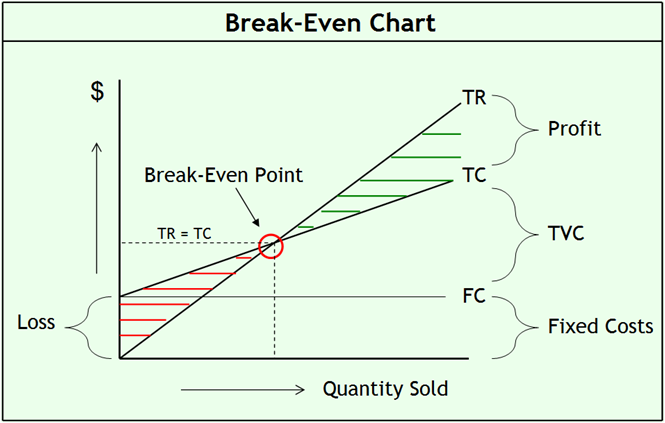
The following are the uses of a break-even graph:
- To advise the company on the amount of products that need to be produced to have the total costs and total revenue be the same; at this point, the profit of the firm is nil
- The approach can be used to calculate the amount of profit or loss that can be attained if a certain business was to operate at a certain level or a certain output is made from the process.
- It is used to interpolate sales revenue and production costs for an effective management.
A piece of software has been identified as potentially useful for the company.
This software is available as a basic installation at a cost of £8500 and as a professional edition at £10550. Investigations have demonstrated that the potential savings that can be made over the next six years are as follows:
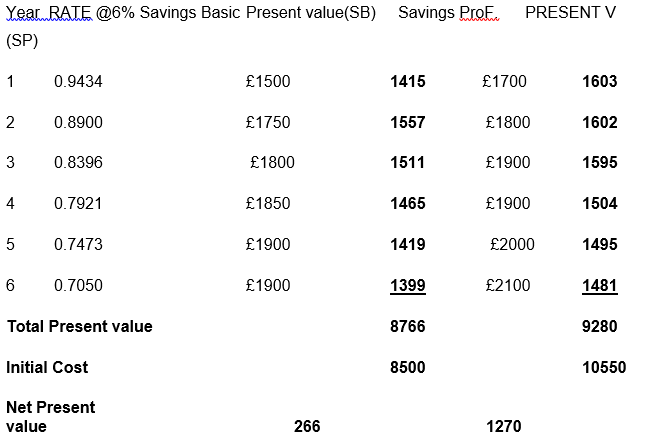
Assuming an interest rate of 6%, use the discount tables in your notes, to calculate the NPV (net present value) for both editions of the software and give a purchase recommendation.
The company should use adopt a saving basic project since at the end of the life period of the project, it is expected to have a net benefit to the organization. The professional method savings will be lower than the initial outlay of capital in its initiation thus when implemented, then the organization is likely to suffer some losses. This should be avoided.
Quality
In project management, quality means a measure of excellence, conformity and the degree at which the output meets the standards of an expected outcome; when something is said to be of good quality, then it has no defects or the defects are not substantial.
Quality assurance
Process involves systematic monitoring and evaluation of the projects to ensure that the set standards conform to the requirements of the project in the efforts of ensuring that at the end of the project the output conform to the set standards and quality is maintained or attained.
Quality management
The overall strategic management of avoiding any risk that can lead to compromised quality, generally, it involves the following processes quality planning, quality control, quality assurance and quality improvement; when every process is well undertaken, then the output of a project are more likely to offer satisfactory results.
Management system
A management system are tools enacted within an organization to ensure that processes are well conducted and operated in the best manner for the interest of coming up with good results as they had been expected or planned
Quality management system
The systems are put in place to ensure that the operating system has the best outcome in terms of quality, and the results are generally within the accepted defects limit. The programs aims at ensuring that all loopholes that are likely to bring unsatisfying results have been looked into and sealed where possible.
How quality can be controlled within projects
Quality management and controlling starts with the initial planning and preparations that a project manager has undertaken, after planning, the manager and team members should continue to monitor and ensure that the set procedures and processes are undertaken in the best manner possible. The following is the approach undertaken in when controlling quality of a project:
- The management should set some predetermined standards that define the best outcome of every process in a project.
- Have some quality specifications and work packages as well the derivable that are expected from individual processes.
- Have well defined procedures that need to be followed in the attainment of overall project objectives.
- Have quality audits well planned and spaced to ensure that from the start, quality and compliance is adhered to.
- After the completion of some work, there is need to have a quality compliance revision.

Monitoring and controlling a project
Monitoring involves in ensuring that the enacted programs, processes and tasks are operated in the best way; it involves ensuring that the project can be finished using the available resources effectively.
Controlling means creating a level of efficiency and ensuring that the resources of a project are well allocated and they are distributed in the best manner possible to facilitate the attainment of project objectives and goals.
The benefits and major issues regarding project monitoring and control
Monitoring and control are crucial stages of a project; they have the following benefits to the project:
- It ensures that resources (time, money and human) are effectively managed
- It ensures that the initiation documents are respected and the entire project is operated following the set standards.
- When a project is well monitored and controlled, it ensures that the objectives and goals it was made to attain have been attained in the most efficient manner.
Despite the benefits that come with monitoring and controls, the following issues are faced:
- The management may have some conflicting issues
- Sometimes the monitors and controllers may overlook some things that eventually leads to failure of the project
- Monitoring may consume some time and resources of a project and hinder the attainment of the set goals in time and costs as planned.
The options available if there is a problem with a project
In case there is a problem in time, costs or quality, managers should be flexible to make decisions depending with the situation at hand. When there have been a delay, managers can opt to extend the time, if not possible they can work for longer hours, they can also subcontract some tasks or even adopt faster technology.
When the issue facing a project is on costs, the management should interpolate the situation and see the best way they can manage the costs, managing costs can be through using other materials (they should be careful not to use substandard materials). They can also opt to substitute some expenses, for example, they can use machinery instead of human resource if the method will offer a reduced cost. In a well-planned project, managers should have a provision that the costs may change upwards so they should have some supplementary budget or miscellaneous expenses budget, they can be used.
Non-compliance of quality standards offers project managers the hardest task; there is no option to offer lower quality to a project, to rectify low quality issues, the managers should get back to the drawing board and start improving the quality from where the right step was lost.